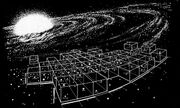No edit summary |
Renegade54 (talk | contribs) m (formatting) Tag: sourceedit |
||
| (24 intermediate revisions by 6 users not shown) | |||
| Line 1: | Line 1: | ||
| − | [[File: |
+ | [[File:The Explored Galaxy.jpg|thumb|The locations of Beta Geminorum and Pollux on "The Explored Galaxy" star chart]] |
| − | The '''Beta Geminorum system''' |
+ | The '''Beta Geminorum system''' (also known as the '''Pollux system''') was a [[star system]]. Its [[star|primary]] [[Beta Geminorum]] was orbited by at least five [[planet]]s. The closest [[starbase]] was [[Starbase 12]]. ({{TOS|Who Mourns for Adonais?}}) |
| + | When surveying [[Pollux V]] and the rest of the Pollux system in [[2267]], the {{USS|Enterprise|NCC-1701}} detected a statistically unexpected absence of intelligent life at first. However, the ships's crew soon encountered [[Apollo]], the last member of [[Greek god|his species]] of ancient intelligent [[humanoid]]s, on [[Pollux IV]]. ({{TOS|Who Mourns for Adonais?}}) |
||
| − | Pollux IV was the ancient [[homeworld]] of the [[Greek god]]s. ({{TOS|Who Mourns for Adonais?}}) |
||
| + | In [[2293]], the location of Beta Gemiinorum in the [[Milky Way Galaxy]] was labeled in a [[star chart]] that was in [[Captain]] [[James T. Kirk]]'s [[quarters]] aboard the {{USS|Enterprise|NCC-1701-A|-A}}. ({{film|6}}, ''[[okudagram]]'') |
||
| ⚫ | |||
| ⚫ | |||
| − | * [[Beta Geminorum]] ([[star|primary]]) |
||
| − | ** Pollux I |
||
| − | ** Pollux II |
||
| − | ** Pollux III |
||
| − | ** [[Pollux IV]] |
||
| − | ** [[Pollux V]] |
||
| + | {{bginfo|Michael Okuda, who created the star chart "The Explored Galaxy", depicted Beta Geminorum and Pollux as two distinct stars, even though they were established to be synonymous in "Who Mourns for Adonais?".|According to ''[[Star Trek: Star Charts]]'' (pgs. 60, 62), the Beta Geminorum system was located in the [[Beta Quadrant]]. Beta Geminorum was a [[Star Trek: Star Charts#Spectral classification|K-class star]] with a [[magnitude]] of +3, which was ten times brighter than [[Sol]]. In the mid-[[22nd century]], this system was located in non-aligned space. In the late [[24th century]], this system was located in or near Federation space.|Pollux V was also featured in the video game ''{{dis|Star Trek: 25th Anniversary|PC}}''.}} |
||
| − | ==Background== |
||
| − | Michael Okuda, who created the chart ''The Explored Galaxy'', believed that Beta Geminorum and Pollux were two distinct stars. So, he created two systems, the Beta Geminorum and the Pollux, and located them in the same region of space. Unlike the situation with another system, [[Canopus]], where the canon never connected Canopus to Alpha Carinae, the canon did established that connection with Beta Geminorum and Pollux. There might be reasons that could be postulated to explain this situation, but without a statement from Mr. Okuda, the definitive reason for this retcon can't be known. |
||
| − | |||
| − | ===''The Explored Galaxy''=== |
||
| − | This chart was also seen in several ''[[Star Trek: The Next Generation]]'' and ''[[Star Trek: Deep Space Nine]]'' episodes set in the [[24th century]], from the year [[2364]] to [[2370]]. These were: {{TNG|Conspiracy|The Measure Of A Man|The Emissary|The Mind's Eye|The Game}} and {{DS9|In the Hands of the Prophets|Cardassians}}. |
||
| − | |||
| − | ===''[[Star Trek: Star Charts]]''=== |
||
| − | Unlike Mr. Okuda, [[Geoffrey Mandel]] believed that Beta Geminorum and Pollux were the same system. This system was located in the [[Beta Quadrant]]. System's primary was a [[Star Trek: Star Charts#Spectral classification|K-class star]]. This star had a magnitude of -1, which was 100 times brighter than [[Sol]]. (page 60) |
||
| − | |||
| − | == Apocrypha == |
||
| − | Pollux V was also featured in the video game ''[[Star Trek: 25th Anniversary (PC)|''Star Trek: 25th Anniversary'']]. |
||
== External link == |
== External link == |
||
Revision as of 17:32, 12 February 2015

The locations of Beta Geminorum and Pollux on "The Explored Galaxy" star chart
The Beta Geminorum system (also known as the Pollux system) was a star system. Its primary Beta Geminorum was orbited by at least five planets. The closest starbase was Starbase 12. (TOS: "Who Mourns for Adonais?")
When surveying Pollux V and the rest of the Pollux system in 2267, the USS Enterprise detected a statistically unexpected absence of intelligent life at first. However, the ships's crew soon encountered Apollo, the last member of his species of ancient intelligent humanoids, on Pollux IV. (TOS: "Who Mourns for Adonais?")
In 2293, the location of Beta Gemiinorum in the Milky Way Galaxy was labeled in a star chart that was in Captain James T. Kirk's quarters aboard the USS Enterprise-A. (Star Trek VI: The Undiscovered Country, okudagram)
In 2371, the location of Beta Geminorum was labeled on a star chart Data and Picard were studying in stellar cartography on the USS Enterprise-D. (Star Trek Generations, okudagram)
